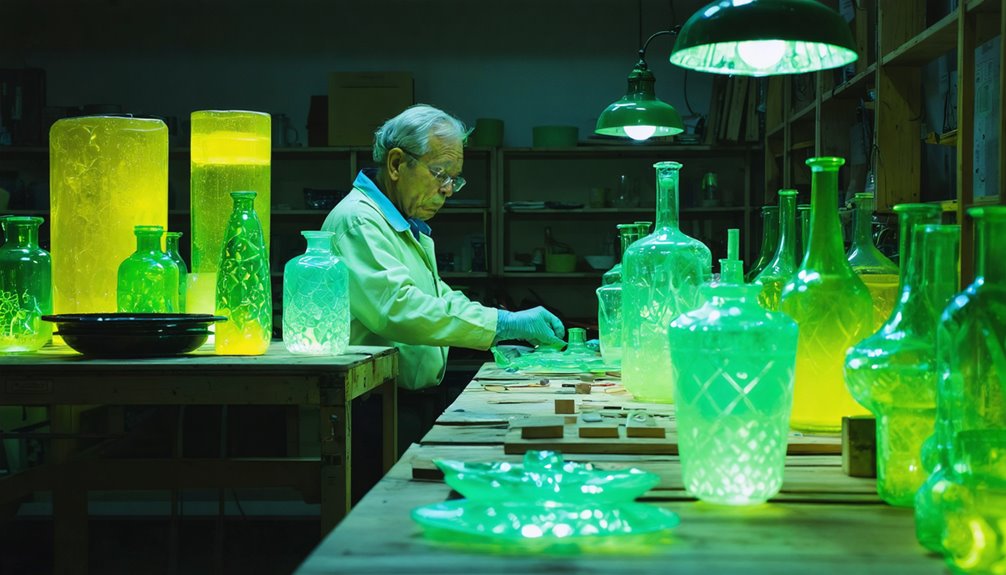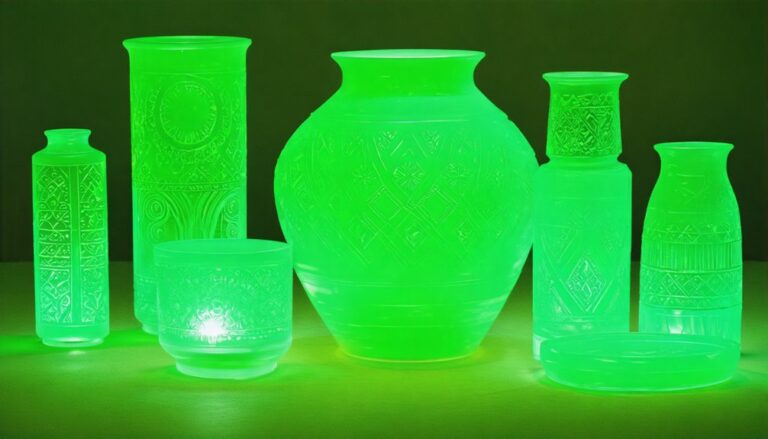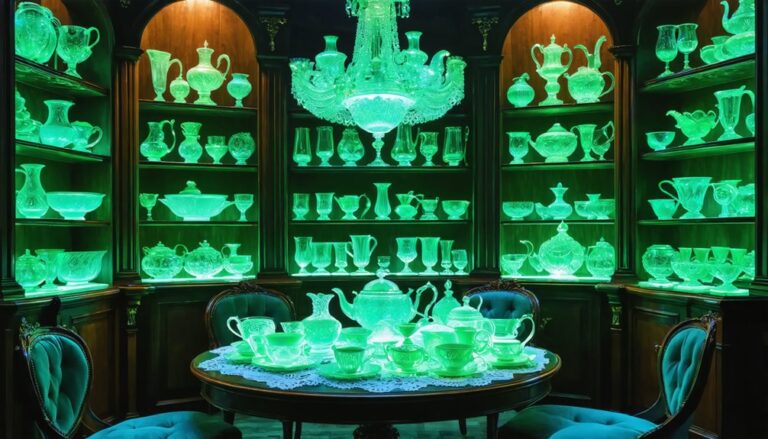The Change in Regulations Affecting Uranium Glass Production

Uranium glass has a fascinating history. During World War II, the U.S. government changed how uranium was used. They diverted uranium supplies to support the atomic weapons program. This decision halted uranium glass production from 1943 to 1958.
After the war, the Nuclear Regulatory Commission introduced strict guidelines. These rules allowed manufacturers to only use depleted uranium. This change aimed to reduce potential hazards and lower radiation exposure for glassmakers and consumers.
As a result, the availability of uranium glass decreased. Collectors noticed a significant scarcity in the market. This rarity increased the value of historic pieces. There’s still much to explore about the effects of these regulations on the glass industry and the unique artifacts it produced.
Key Takeaways
Uranium glass production stopped during World War II from 1943 to 1958. The government classified uranium as a controlled substance. This decision halted many manufacturing processes.
In 1958, regulations changed. The U.S. allowed uranium glass production to start again. However, manufacturers could only use depleted uranium. This was to lower any radiation risks associated with the glass.
Today, the Nuclear Regulatory Commission oversees how uranium glass is used. They permit it for display purposes. However, they strongly advise against using it for food or drink. This is to ensure safety for consumers.
Modern safety standards have led to a decline in uranium glass production. This has made vintage pieces more unique and rare. Collectors find them fascinating because they represent a specific era in glassmaking.
After 1958, restrictions on uranium access impacted the collectible market. Fewer items became available, which increased their value. Collectors now seek these items for their historical significance and rarity.
The development of manufacturing techniques for uranium glass has evolved over the years. Each change in regulation has shaped how this glass is made and used. Understanding this history helps appreciate the art and science behind uranium glass.
Historical Context of Uranium Glass Regulations
Uranium glass first emerged in the 1830s. At that time, manufacturers had easy access to uranium compounds. This led to its quick rise in popularity during the Victorian era.
However, things changed with World War II. The need for uranium shifted dramatically. Governments focused on using uranium for nuclear weapons, which halted production from 1943 to 1958.
After the war, the U.S. government implemented strict regulations in 1958. They classified uranium as a controlled substance. This made it difficult to produce uranium glass.
Many years later, in 2001, a qualified health physicist conducted a safety assessment. This assessment showed that the radioactivity in uranium glass presented minimal risk when used for display.
Today, there’s a limited revival of uranium glass. This revival uses depleted uranium and is under careful regulatory oversight.
Even with strict controls, the unique beauty of uranium glass still captures the interest of collectors and enthusiasts.
Health Concerns and Heavy Metal Exposure
Uranium glass, known for its distinctive glow and vintage appeal, has an interesting history tied to the development of manufacturing techniques. This glassware gained popularity in the late 19th and early 20th centuries when manufacturers began experimenting with uranium to enhance the brilliance and color of glass. They discovered that adding uranium oxide produced a striking green or yellow hue, which captivated consumers.
While uranium glass is a beautiful collectible, it’s crucial to be aware of its heavy metal content. The main health risks are linked to the toxicity of uranium, not its radioactivity. Long-term exposure, particularly through ingestion, can lead to significant health issues like kidney damage, especially when acidic foods or beverages cause uranium to leach from the glass.
The U.S. Nuclear Regulatory Commission has deemed uranium glass safe for display and collection, but they recommend against using it for food or drinks. To keep yourself safe, handle your uranium glass with care. Avoid using it for eating or drinking, and practice safe handling to limit any exposure to heavy metal contaminants.
Uranium glass is safe for display, but avoid using it for food or drinks to minimize exposure to heavy metal contaminants.
Enjoy your collection while prioritizing your health.
Impact of World War II on Uranium Glass Production
The history of uranium glass production took a significant turn during World War II. This war dramatically impacted the availability of uranium oxide. The U.S. government focused on uranium for atomic weapons, leading to severe shortages. As a result, glass manufacturers had to stop their production by 1943.
After this halt, uranium glass was no longer available on the market for over ten years. This gap in production lasted until the late 1950s when regulations became less strict. The wartime priorities reshaped the industry and changed how manufacturers approached materials.
Once the war ended and supplies returned, glassmakers had to adapt their techniques to meet new safety standards. The resurgence of uranium glass in the late 1950s marked a fresh chapter in its history. It demonstrated how external events can influence manufacturing and innovation in unexpected ways.
Uranium Supply Shortage

Uranium glass, once a popular decorative item, faced significant challenges during and after World War II. The military’s need for uranium resources led to strict regulations. From 1943 to 1958, uranium glass production halted entirely. The government classified uranium as a controlled substance. This decision sharply limited the availability of uranium for consumer products.
After the war, the demand for uranium shifted. Nuclear energy development and weapons manufacturing became the primary focus. This change intensified the existing uranium shortage. Many manufacturers of uranium glass found it impossible to continue. They couldn’t compete for scarce supplies or adapt to the new rules.
Eventually, the industry found a new path. Manufacturers turned to depleted uranium. This material has much lower radioactivity and is more readily available. With this shift, uranium glass production cautiously resumed.
However, it never regained its former popularity or market presence. The techniques used in manufacturing also evolved, reflecting the industry’s adaptation to changing circumstances.
Wartime Production Shift
During World War II, the supply of uranium faced a significant shortage. The U.S. government made strategic choices that put military needs first. This meant that civilian manufacturing, such as uranium glass production, took a backseat.
As the war escalated, regulations became strict. Uranium was classified as a vital strategic material. Manufacturers had to stop making uranium glass completely starting in 1943. The radioactivity of uranium turned into a key asset for military purposes, rather than for decorative items.
This sudden change had a major impact on civilian manufacturing. The availability of uranium glass dropped sharply. Even when production started again after the war, the type of uranium used changed. Depleted uranium, which is less radioactive than natural uranium, became the norm.
This shift marked a lasting change in the industry. World War II fundamentally altered uranium glass manufacturing, tying it closely to national security needs.
The development of manufacturing techniques was also affected. With the focus on military objectives, innovation in civilian uses lagged behind. The once vibrant market for uranium glass diminished, and the industry was forever transformed.
As civilian priorities faded, the legacy of wartime production shaped the future of uranium glass.
Postwar Manufacturing Halt
World War II ended in 1945, but the production of uranium glass did not return to normal right away. Strict government regulations kept civilian manufacturing on hold until 1958. Uranium was crucial for military operations, so authorities closely monitored its use. This control led to a long pause in manufacturing.
During this time, glassmakers adapted by using depleted uranium instead. This shift allowed them to meet new standards and resume production. The uranium glass produced before the war became highly sought after by collectors. It represented exclusivity and status.
Here’s a look at the timeline of uranium sources and their availability:
| Period | Uranium Source | Availability |
|---|---|---|
| Pre-1943 | Natural Uranium | Abundant |
| 1943-1958 | Restricted | Scarce (Military Use) |
| 1958-1978 | Depleted Uranium | Moderate (Peak Period) |
| Post-1978 | Depleted Uranium | Declining Interest |
This timeline highlights how uranium glass reflects resilience despite postwar limitations. Collecting these pieces makes a strong statement about history and innovation.
Changes in Uranium Usage Post-War
After World War II, the use of uranium changed a lot. Before the war, uranium was popular for making glass, but the end of the conflict saw a big shift to military uses. This shift made it tough for manufacturers of uranium glass. The U.S. government stepped in with strict rules about mining and using uranium. Because of this, production of uranium glass stopped completely from 1943 to 1958.
During this time, the military took priority. Manufacturers struggled to get the uranium they needed for their products. Once the rules loosened in the late 1950s, companies began using depleted uranium. This type of uranium has much lower radioactivity than natural uranium.
However, even with the switch to depleted uranium, people became more aware of radiation risks. Safety concerns grew, and this affected the popularity of uranium glass. As a result, fewer collectors showed interest, changing the course of the industry after the war.
The focus on military needs and safety issues reshaped how uranium glass was made and viewed in society.
Modern Regulatory Standards for Uranium Glass
Uranium glass has a fascinating history tied closely to its manufacturing techniques. Initially produced in the 1830s, it gained popularity due to its vibrant green color and unique glow under ultraviolet light. The glass was made using uranium dioxide, which gave it these distinct characteristics.
Over the years, production methods evolved. Early glassmakers used trial and error to enhance the glass’s appearance and durability. They experimented with different formulations and techniques. By the late 19th century, uranium glass was widely crafted for decorative items and tableware. The Industrial Revolution played a key role, enabling mass production and making these items more accessible to consumers.
During World War II, production came to a standstill. Concerns about radiation and the war effort led to a complete halt from 1943. After the war, production resumed in 1958 with a focus on using depleted uranium. This material has lower radioactivity, making it safer for use in collectible items.
Today, uranium glass is regarded as a historical artifact. Collectors cherish it for its unique qualities and the story behind its creation. However, modern regulations now govern its use. The Nuclear Regulatory Commission limits its application, allowing only for display, while banning any contact with food or drink. Understanding these regulations is essential for anyone interested in this captivating glassware.
To appreciate uranium glass fully, you should know the following:
- Guidelines from the NRC on safety for handling and displaying uranium glass.
- Potential risks related to heavy metal leaching from the glass.
- The impact of regulations on the status of uranium glass as a collectible.
This knowledge enhances your appreciation of uranium glass, connecting you to its rich history and the careful considerations of today’s safety standards.
Collectors and the Influence of Regulations

Uranium glass has a fascinating history shaped by various regulations. Collectors should know how these rules have influenced both the availability and appeal of different pieces.
For instance, after 1958, government restrictions limited the access manufacturers had to uranium. This led to a significant drop in uranium glass production. As a result, early items became rare and sought after, particularly those made before World War II, when manufacturing was halted in 1943.
The shift to using depleted uranium marked a change in both radioactivity and composition. Collectors today often seek vintage uranium glass because it combines scarcity with historical importance.
Understanding these regulations can help collectors make informed decisions. Scarcity and historical value make certain pieces more desirable in the current collectibles market.
Collectors who stay updated on these regulatory impacts can position themselves better. This knowledge can lead to smarter investments in this unique niche.
The history of uranium glass and its production techniques adds depth to the collector’s journey.
Frequently Asked Questions
Why Is Uranium Glass Not Made Anymore?
Uranium glass, also known as Vaseline glass, has a fascinating history that intertwines with advancements in manufacturing techniques. This unique glass contains small amounts of uranium, which gives it a distinctive green or yellow color and makes it glow under ultraviolet light.
The production of uranium glass became popular in the late 19th century. Manufacturers discovered that adding uranium to glass could enhance its brilliance and durability. This led to a surge in popularity during the Art Deco period. Many households embraced uranium glass for its aesthetic appeal and novelty.
However, as time went on, safety concerns emerged. Scientific studies began to highlight the potential health risks associated with uranium exposure, even in small amounts. People became increasingly aware of the environmental impact of producing such materials. These factors contributed to a decline in public interest.
Legal issues also played a role. Stricter regulations regarding radioactive materials made it challenging for manufacturers to continue producing uranium glass. High production costs further complicated the situation. While collectors still appreciate the historical significance of uranium glass, the market for it has become limited.
Today, alternative materials are more widely available, and public perception has shifted. Many consumers prefer safer options. The combination of these factors has led to the cessation of uranium glass production, making it a relic of a bygone era.
What Are the Restrictions on Uranium?
Uranium glass has a fascinating history. It emerged in the 1830s when manufacturers discovered the unique properties of uranium. This glass, often called “Vaseline glass,” glows under ultraviolet light due to the uranium content.
The development of manufacturing techniques for uranium glass evolved over the years. Early glassmakers experimented with various materials. They found that adding uranium to the glass mixture produced vibrant colors and a distinct glow. This innovation captured the attention of consumers. It became popular for decorative items, tableware, and even jewelry.
Safety regulations around uranium glass became important as awareness of radiation increased. While uranium is radioactive, the levels in glass are generally low. However, producers had to comply with stricter guidelines to protect workers and consumers. These regulations helped ensure that the glass was safe for everyday use.
As time went on, the popularity of uranium glass waned. By the mid-20th century, concerns about radiation led to a decline in its production. Still, collectors and enthusiasts appreciate its unique beauty and historical significance. Today, many people seek out uranium glass for its aesthetic appeal and the stories it carries.
When Was Uranium Glass Banned?
Uranium glass, also known as Vaseline glass, has a fascinating history. Its production began in the early 19th century, and it became popular due to its vibrant color and unique glow under ultraviolet light. Manufacturers used small amounts of uranium oxide to achieve this striking appearance.
However, concerns about health risks emerged over time. By World War II, many countries started banning the use of uranium in glassware. The fear was primarily about radiation exposure and its potential health effects on consumers.
Even after the bans, some collectors still seek out these vintage items. They appreciate the craftsmanship and the rich history behind uranium glass. It’s a reminder of a time when innovative manufacturing techniques led to both beauty and controversy in household items.
Today, while uranium glass is no longer produced, it remains a significant part of glassware history. Collectors value it not only for its aesthetic appeal but also for the lessons learned about safety and manufacturing practices.
Does the US Still Enrich Uranium?
Yes, the U.S. still enriches uranium. They use advanced methods to separate isotopes. This process mainly supports nuclear energy and creates fuel for reactors. It is also relevant for national defense. Safety and regulations are taken seriously in these operations.
Uranium enrichment has a rich history. It started in the early 20th century. Scientists discovered that different isotopes of uranium could be separated. Over time, various techniques emerged. These included gas diffusion and centrifuges. Each method improved efficiency and output.
Today, the U.S. continues to innovate in uranium manufacturing. They focus on safety and environmental protection. The goal is to meet energy needs while minimizing risks. Experts monitor these processes closely. They ensure compliance with national and international standards.
Conclusion
Uranium glass has a fascinating history that dates back to the early 19th century. Initially, it was created to enhance the colors of glassware. The bright green or yellow hues that result from adding uranium compounds made these pieces visually striking. Over time, manufacturers developed new techniques to incorporate uranium into glass, improving both its aesthetic appeal and durability.
As the years went by, uranium glass became popular among collectors and everyday users. However, concerns about health risks associated with uranium exposure emerged. This led to a shift in regulations aimed at ensuring safety. Despite these challenges, collectors remain captivated by uranium glass. They adapt to new rules while continuing to treasure these unique items.
The evolution of manufacturing techniques plays a critical role in the story of uranium glass. Innovations in glassmaking allowed for more intricate designs and colors. Even today, as laws change, the legacy of uranium glass endures. It still captures our curiosity. The future will reveal how new regulations might further influence its production and our interest in this captivating material.





